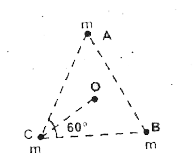Three particles each of mass m are kept at vertices of an equilateral triangle of side L. The gravitational field at centre due to these particle is
zero
3GML2
9GML2
12GM√3L2
The correct Answer is:A
To find the gravitational field at the center of an equilateral triangle formed by three particles each of mass m located at the vertices, we can follow these steps:
1. Identify the Configuration:
We have three particles of mass m placed at the vertices of an equilateral triangle with side length L. Let the vertices be labeled as A, B, and C.
2. Determine the Position of the Center:
The center of the equilateral triangle (centroid) is located at a distance of L√3 from each vertex.
3. Calculate the Gravitational Field Due to One Particle:
The gravitational field E due to a single particle at a distance r is given by the formula:
E=Gmr2
Here, r=L√3. Therefore, the gravitational field due to one particle at the center is:
EA=Gm(L√3)2=Gm⋅3L2=3GmL2
4. Direction of the Gravitational Fields:
The gravitational field vectors EA, EB, and EC due to particles at A, B, and C will point towards the respective particles. The angles between each pair of these vectors is 120∘.
5. Vector Addition of Gravitational Fields:
Since the magnitudes of the gravitational fields are equal and the angles between them are 120∘, we can use vector addition to find the resultant gravitational field at the center:
Enet=EA+EB+EC
However, due to symmetry, the components of these vectors in any direction will cancel out. Therefore, the net gravitational field at the center will be:
Enet=0
Final Answer:
The gravitational field at the center of the triangle due to the three particles is 0.
---
We have three particles of mass m placed at the vertices of an equilateral triangle with side length L. Let the vertices be labeled as A, B, and C.
The center of the equilateral triangle (centroid) is located at a distance of L√3 from each vertex.
The gravitational field E due to a single particle at a distance r is given by the formula:
E=Gmr2
Here, r=L√3. Therefore, the gravitational field due to one particle at the center is:
EA=Gm(L√3)2=Gm⋅3L2=3GmL2
The gravitational field vectors EA, EB, and EC due to particles at A, B, and C will point towards the respective particles. The angles between each pair of these vectors is 120∘.
Since the magnitudes of the gravitational fields are equal and the angles between them are 120∘, we can use vector addition to find the resultant gravitational field at the center:
Enet=EA+EB+EC
However, due to symmetry, the components of these vectors in any direction will cancel out. Therefore, the net gravitational field at the center will be:
Enet=0
The gravitational field at the center of the triangle due to the three particles is 0.
Topper's Solved these Questions
- GRAVITATIONBook:DC PANDEYChapter:GRAVITATIONExercise:Check Point 10.4
Explore 10 Videos
- GRAVITATIONBook:DC PANDEYChapter:GRAVITATIONExercise:Check Point 10.5
Explore 20 Videos
- GRAVITATIONBook:DC PANDEYChapter:GRAVITATIONExercise:Check Point 10.2
Explore 20 Videos
- GENERAL PHYSICSBook:DC PANDEYChapter:GENERAL PHYSICSExercise:INTEGER_TYPE
Explore 2 Videos
- KINEMATICSBook:DC PANDEYChapter:KINEMATICSExercise:INTEGER_TYPE
Explore 11 Videos
Similar Questions
Three particles, each of mass m are placed at the vertices of an equilateral triangle of side a. What are the gravitation field and gravitational potential at the centroid of the triangle.
View SolutionThree particles, each of mass m are fixed at the vertices of an equilateral triangle of side length a. The only forces acting on the particles are their mutual gravitational forces. Then answer the following questions.

Force acting on particle C, due to particle A and B
View Solution
Knowledge Check
Three particles each of mass m are kept at the vertices of an euilateral triangle of side L. The gravitational field at the centre due to these particle is
AzeroB3GML2C9GML2D2GML2Three particles each of mass m are kept at the vertices of an euilateral triangle of side L. The gravitational field at the centre due to these particle is
A−3GMLB−√3GMLC−3√3GMLD−GM3√3LThree particles each of mass m are palced at the corners of an equilateral triangle of side b. The gravitational potential energy of the system of particle is
A−3Gm22bB−Gm22bC−3Gm2bD−Gm2b
Three mass points each of mass m are placed at the vertices of an equilateral tringale of side l. What is the gravitational field and potential due to three masses at the centroid of the triangle ?
View SolutionThree particles, each of mass m are fixed at the vertices of an equilateral triangle of side length a. The only forces acting on the particles are their mutual gravitational forces. Then answer the following questions.

The gravitational potential at O is
View SolutionThree mass points each of mass m are placed at the vertices of an equilateral tringale of side l. What is the gravitational field and potential due to three masses at the centroid of the triangle ?
View SolutionThree identical point objects each of mass m are placed at the vertices of an equilateral triange of side l. What is the gravitational potential at the centre of the equilateral triangle due to the point masses?
View SolutionThree particles, each of the mass m are situated at the vertices of an equilateral triangle of side a. The only forces acting on the particles are their mutual gravitational forces. It is desired that each particle moves in a circle while maintaining the original mutual separation a. Find the initial velocity that should be given to each particle and also the time period of the circular motion. (F=Gm1m2r2)
View Solution
